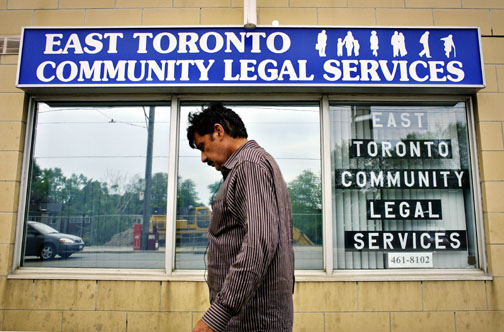As Toronto’s legal clinics
prepare to consider a merger, some groups are raising concerns about the pending proposal to have only three mega clinics in the city.

“In particular, we are concerned that this amalgamation does not reflect a model of community lawyering that responds to the needs of low-income people,” said the Law Union of Ontario in a recent letter to Legal Aid Ontario chief executive officer Bob Ward and the Ministry of the Attorney General.
In addition, one of the Toronto clinics, Kensington-Bellwoods Community Legal Services, is expressing concern about the plan to create three clinics for Toronto. In a notice last week, LAO said the clinic had pulled out of the project. The clinic itself says it hasn’t withdrawn but is merely highly critical of the proposal as it stands.
“We do not believe that mega clinics reflect a community-based model for service delivery,” Kensington-Bellwoods clinic chairman Gary Newhouse wrote on the board’s behalf in a response to the merger proposal. The response noted the proposal that has been circulating would also create a clinic in both Peel and York regions. The Kensington-Bellwoods clinic has begun a campaign to stop the proposal and has been circulating a petition against it.
In response to the criticism, LAO noted it’s the Toronto-area clinics themselves that are leading what it calls the transformation project.
“While Legal Aid Ontario supports this project, it is Ontario’s clinics who are leading the GTA transformation project,” it said in a response to the Law Union of Ontario’s letter.
“Legal Aid Ontario and legal clinics must adjust to demographic shifts and changing needs in the Greater Toronto Area in order to better serve low-income people in their communities,” said Jayne Mallin, LAO senior counsel for clinic transformation, in a separate response.
“It’s really unfortunate that they’re misstating some pretty critical facts,” says Jack De Klerk, one of the project leads for the transformation efforts, of the Kensington-Bellwoods clinic’s position.
He denies, for example, the mergers will affect community relationships, noting the current proposal would have four community development workers at each of the new clinics. With funding constraints over the years, there are now only about three or four community development workers across the 17 Toronto area clinics, he points out.
“When they say we’re going to lose it, I would say that’s unfair or inaccurate,” he says, adding under the current structure of about seven or eight staff per clinic, most organizations are too small to provide the range of services communities need.
The merger proposal follows several years of discussions about changing the way legal clinics work. The efforts culminated with a 2013 report by six east Toronto clinics aimed at finding more efficient ways to deliver services.
The report raised the need for mergers with more details now under consideration for the three clinics in Toronto as well as the two others proposed for Peel and York regions. Almost all Toronto clinics signed a memorandum of understanding that acknowledged problems with the current catchment areas, concerns about the ability of small organizations to increase their capacity, inconsistencies in the range of services provided, and the fact the allocation of human resources doesn’t recognize changes to the location of the region’s low-income population.
The memorandum also emphasized the importance of community boards of directors and the need to continue the full range of services. It also acknowledged the need for larger clinics.
According to the Kensington-Bellwoods clinic, the merger proposal has provided for local access points. Newhouse, however, still has concerns over whether the merged clinics will be able to serve local needs.
“Very little content is offered regarding these ‘access points,’” he said in his letter.
In its response, LAO said the idea is to invest any savings into client services. It also said 15 other Toronto area clinics remain on board with the project.
At the moment, De Klerk, who’s also director of legal services at Neighbourhood Legal Services, says those behind the merger proposal are in the midst of finalizing their report in the next two weeks. After that, they’ll be asking the clinics to offer their views on how the new structure would work for them by the end of the year. From there, the idea is to look at how to implement the changes, he says.

 “In particular, we are concerned that this amalgamation does not reflect a model of community lawyering that responds to the needs of low-income people,” said the Law Union of Ontario in a recent letter to Legal Aid Ontario chief executive officer Bob Ward and the Ministry of the Attorney General.
“In particular, we are concerned that this amalgamation does not reflect a model of community lawyering that responds to the needs of low-income people,” said the Law Union of Ontario in a recent letter to Legal Aid Ontario chief executive officer Bob Ward and the Ministry of the Attorney General.